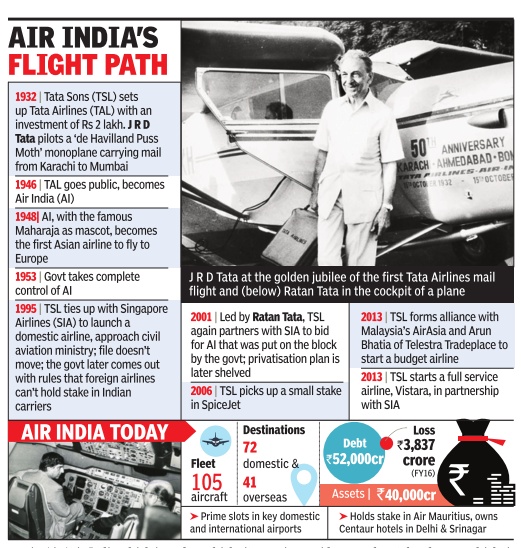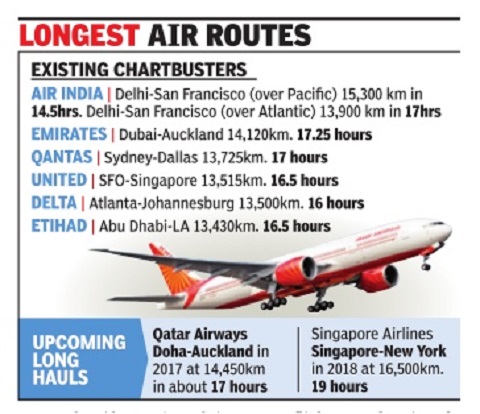Air India

Contents |
Irregularities
2004-14: Purchase of aircraft
Neeraj Chauhan, `Blatant irregularities crashed Air India', May 31, 2017: The Times of India
Airline Bought 111 Planes For Rs 70,000Cr When Its Profit Was Just Rs 100Cr, Reveal CBI FIRs
The Central Bureau of Investigation's three FIRs in the `Air India scam', which took place during the UPA regime, have alleged blatant irregularities that hastened the downfall of the national carrier.
The FIRs, accessed by TOI, said the civil aviation ministry decided to purchase 111aircraft for Air India costing about Rs 70,000 crore at a time when the airline was showing a profit of about Rs 100 crore and didn't have the capacity to purchase even a few aircraft. Due to this particular decision, the airline immediately went into huge losses, which increased every year to reach tens of thousands of crores, the CBI said, quoting from the allegation levelled by activist-lawyer Prashant Bhushan in his PIL before the Supreme Court.
The FIRs mentioned an internal Air India report of 2000-01 which said the airline should only lease aircraft and not go for purchase.The view was overruled by the aviation ministry , the FIR said, quoting from Bhushan's allegations which led the SC to direct a CBI probe.
It was decided in 2004-05 that Air India will buy 68 aircraft instead of 28, as originally planned, a decision which quadrupled the expenditure from Rs 10,000 crore, as originally estimated, to Rs 44,000 crore. This apart, the government also decided to buy 43 planes for Indian Airlines at a cost of Rs 8,399 crore.
“Concerns regarding potential difficulties of Indian Airlines in successfully funding the acquisition process with a positive NPV (net present value) was raised within civil aviation ministry , but were ignored,“ the CBI FIR said, referring to one of the main allegations which led the court to direct the CBI to probe the alleged scam.
Interestingly , the CBI said the acquisition programme had been under consideration since 1996 but never got traction, until 2004 when it suddenly picked up speed. “Between August 2004 and December 2005, the proposals were formulated by Air India, approved by its board, examined and approved by ministry , Planning Commission, department of expenditure, group of ministers and the cabinet,“ the FIR said.
Not just that, Air India signed the contract with Boeing to buy 68 aircraft on the same day , December 30, 2005, that the government cleared the purchase order.
The CBI said NACIL (National Aviation Company of India Ltd), incorporated to merge Indian Airlines and Air India, had an equity base of only Rs 145 crore, yet it made a commitment to pay Rs 44,000 crore for procuring 111new aircraft. It said loans for the purchase were taken from US and Indian banks, pushing the airline into debt and huge losses.
Similarly, the CBI FIR into the leasing of planes said the ministry and officials of Air IndiaIndian Airlines decided to lease planes “dishonestly without due considerations regarding proper route study and marketing or price strategy“.
“The leasing was done despite airline running with very low load because of largescale aircraft acquisition and several flights, especially overseas flights running almost empty at a huge loss,“ the CBI said.
For example, Air India leased 15 expensive planes when it did not have pilots to fly the aircraft, the FIR said, emphasising that this was “known to everyone“.
In another instance of alleged irregularity , Air India dry leased four Boeing 777s for a period of five years in 2006 even when new planes for the airline were set to arrive in July 2007.
This “resulted in five Boeing 777s and five Boeing 737s standing idle, leading to an estimated loss of Rs 840 crore during 2007-2009“, the CBI said.
The third FIR to probe Air India giving up profitable routes and schedules for private airlines alleged that “foreign airlines were given unrestricted entry into India and major routes were given to them without taking any reciprocal benefits“.
Air India gave up Kolkata-Bangkok, Kolkata-Dhaka, Doha-Kochi, Kochi-Kuwait and domestic routes like Ahmedbad-Jaipur, MumbaiVadodara, Pune-Goa and MumbaiPatna and others.
“On all these routes, private airlines like Jet Airways, Kingfisher, Go Air, Indigo, Spicejet, Paramount Airways etc started operating and made profits,“ the FIR said.
On lucrative routes like Mumbai-Dubai and Mumbai-Doha, Air India reduced its flights and gave private airlines major market share, it added.
Longest flights
Delhi- San Francisco: 15,300 kilometres in 14.5 hours
Junks Atlantic Route, Covers Longer Distance Than Any Other Flight
Flying Delhi to San Francisco (SFO) over the Pacific Ocean instead of the Atlantic, as it had done till last week, has earned Air India the record of operating the world's longest nonstop flight.
The Pacific route is almost 1,400km longer than the Atlantic one, and the flight covered 15,300 kilometres in 14.5 hours.Despite the route being longer, the flight took almost two hours less thanks to tailwinds -winds that blow in the same direction as an aircraft and thus make it go faster.
“The Earth rotates from west to east, and winds flow in that direction too. Flying west means facing strong headwinds (that decreases an aircraft's actual ground speed), and flying east means getting strong tailwinds, which does the opposite,“ said a senior AI official. “While taking the (western) Atlantic route to SFO, we usually face headwinds of 24kmph. This means that if our aircraft is doing 800kmph, its actual ground speed is 776kmph. Taking the (eastern) Pacific route will mean getting tailwinds of 138kmph, which make the aircraft have an actual ground speed of 938kmph,“ the official added.
At 13,900km, the Atlantic route of AI's Delhi-SFO nons top flight made it the world's second-longest after Emirates' Dubai-Auckland (14,120km). Now, AI's Pacific route will remain the world's longest nonstop for two years, till Singapore Airlines launches the mother of all direct flights -Singapore-New York -that will cover 16,500km in 19 hours (see box). The four pilots, captains Rajneesh Sharma, Gautam Verma, MA Khan and SM Palekar, and the 10 cabin crew members who operated the first Delhi-SFO flight over the Pacific are ecstatic at setting this record.
“The aircraft took off from Delhi at 4am on Sunday (October 16) morning. We were in that date till Japan. After that, we crossed the international date line and were in October 15. By the time we landed in San Francisco, it was 6.30am on October 16 (local time in SFO),“ said one of the pilots.
The AI Delhi-SFO-Delhi flight now does a round trip of the world as it flies back to India over the Atlantic to get tailwinds on both the outbound and inbound flights.
The Boeing-777 200 long range used by AI on this route, on an average, burns 9,600 litres of fuel for each hour of flying. A shorter flying time on the Delhi-SFO route -by an hour in summer to three hours in winter -would mean huge fuel savings for the airline.
On-time performance
2007-16
See graphic:
Air India’s losses, 2007-16

2016: third worst in the world
AI ranked world's 3rd worst performer, co disagrees Jan 10 2017 : The Times of India
A report published by data services company FlightStats ranked the airline as the third worst global performer in terms of on-time performance (OTP) in 2016.
Personnel issues
Resignation of pilots, 2012-15
See graphic

This is a collection of articles archived for the excellence of their content. |
